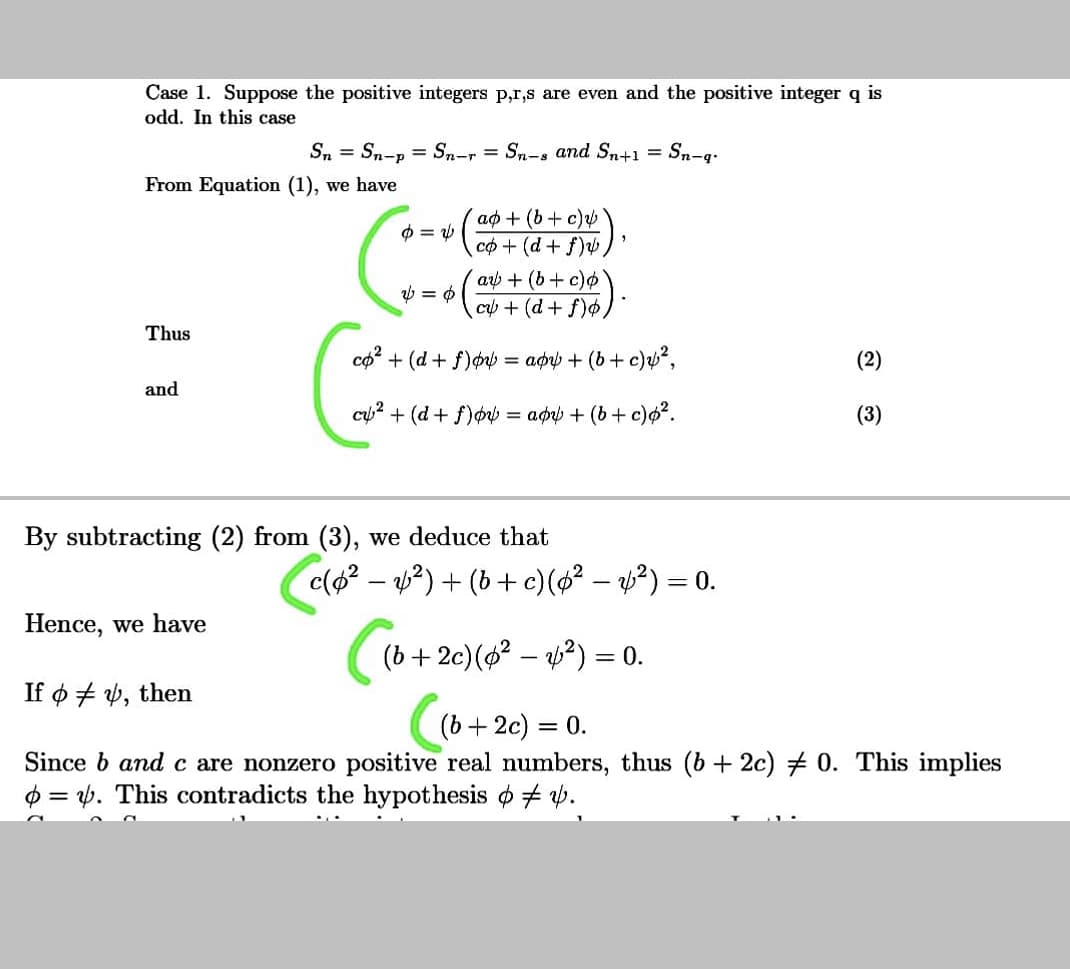Case 1. Suppose the positive integers p,r,s are even and the positive integer q is odd. In this case Sn = Sn-p = Sn-r = Sn-s and Sn+1 = Sn-q. From Equation (1), we have аф + (b + c) co + (d+ f)v ap + (b+c)o cy + (d+ f), Thus + (d+ f)o = apy + (b+ c)u?, (2) and + (d + f)oy = apy + (b+ c)o?. (3) %3D By subtracting (2) from (3), we deduce that c(o – v?) + (b+ c)(? – v²) = 0. | Hence, we have (b+ 2c)(4² – p²) = 0. If o + v, then (b+ 2c) = 0. Since b and c are nonzero positive real numbers, thus (b + 2c) # 0. This implies $ = p. This contradicts the hypothesis o p.
Case 1. Suppose the positive integers p,r,s are even and the positive integer q is odd. In this case Sn = Sn-p = Sn-r = Sn-s and Sn+1 = Sn-q. From Equation (1), we have аф + (b + c) co + (d+ f)v ap + (b+c)o cy + (d+ f), Thus + (d+ f)o = apy + (b+ c)u?, (2) and + (d + f)oy = apy + (b+ c)o?. (3) %3D By subtracting (2) from (3), we deduce that c(o – v?) + (b+ c)(? – v²) = 0. | Hence, we have (b+ 2c)(4² – p²) = 0. If o + v, then (b+ 2c) = 0. Since b and c are nonzero positive real numbers, thus (b + 2c) # 0. This implies $ = p. This contradicts the hypothesis o p.
Algebra & Trigonometry with Analytic Geometry
13th Edition
ISBN:9781133382119
Author:Swokowski
Publisher:Swokowski
Chapter2: Equations And Inequalities
Section2.1: Equations
Problem 75E
Related questions
Question
Show me the steps of determine green and inf is here

Transcribed Image Text:Case 1. Suppose the positive integers p,r,s are even and the positive integer q
odd. In this case
Sn = Sn-p = Sn-r = Sn-s and Sn+1 = Sn-q.
From Equation (1), we have
ap + (b + c)
co+ (d+f)
a + (b+c)
cp + (d+ f)o,
Thus
co? + (d + f) = aørp + (b+ c)u?,
(2)
and
cy? + (d + f)øv = app + (b + c)o?.
(3)
By subtracting (2) from (3), we deduce that
c(a? – 2) + (b + c)(s² – »?) = 0.
Hence, we have
(b+ 2c)(? – y?) = 0.
If ø + 4, then
(b+ 2c) =
= 0.
Since b and c are nonzero positive real numbers, thus (b + 2c) + 0. This implies
$ = 6. This contradicts the hypothesis o + v.

Transcribed Image Text:The main aim of this study is to exhibit some cases on the periodic character of
the positive solutions of the rational difference equation
aSn-q + bSn-r + cSn-s
dSn
Sn+1 = Sn-p
(1)
+ eSn-r + fSn-s ) '
-q
where a, b, c, d, e, ƒ€ (0, 0). The initial conditions S-p, S-p+1;.-,S-q, S-q+1;..,S-r,
S-r+1,...,S-s,...,S_s+1,...,S_1 and So are arbitrary positive real numbers such that
p > q > r > s > 0.
е,
Expert Solution
This question has been solved!
Explore an expertly crafted, step-by-step solution for a thorough understanding of key concepts.
Step by step
Solved in 4 steps

Recommended textbooks for you

Algebra & Trigonometry with Analytic Geometry
Algebra
ISBN:
9781133382119
Author:
Swokowski
Publisher:
Cengage


Elements Of Modern Algebra
Algebra
ISBN:
9781285463230
Author:
Gilbert, Linda, Jimmie
Publisher:
Cengage Learning,

Algebra & Trigonometry with Analytic Geometry
Algebra
ISBN:
9781133382119
Author:
Swokowski
Publisher:
Cengage


Elements Of Modern Algebra
Algebra
ISBN:
9781285463230
Author:
Gilbert, Linda, Jimmie
Publisher:
Cengage Learning,